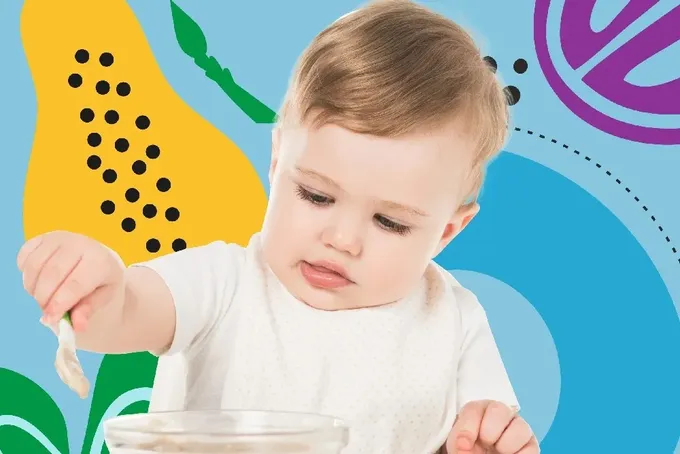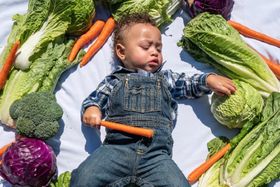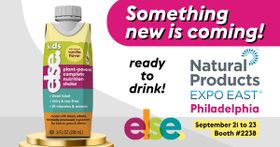1-Year-Old Feeding Schedule: Tips and Guidelines
Creating a feeding schedule for your one-year-old? Get practical tips and guidelines to ensure your toddler gets the nutrition they need for healthy growth and development.
Updated May 28, 2024

If you're transitioning from breastfeeding or bottles, you're likely entering uncharted territory, especially if you're a first-time parent. And, finding the right feeding schedule for a one-year-old can be very confusing. That's why we put together a comprehensive guide to help you decide on the perfect 1-year-old feeding schedule for your baby—you can find all the information in this guide, from how many times you should feed your toddler daily to what serving sizes suit their little stomachs.
» Discover a plant-powered nutritious formula to ease your one-year-old's transition to solid foods
How Often Should I Feed My Toddler?
Most 1-year-olds should have three meals and two snacks every day. This is an age where your toddler has high activity levels but a small stomach, which means they need to eat more often than adults to stay fueled.
It's always a good idea to offer meals and snacks at regular times every day instead of when your little one demands them. When you first introduce solids and five feedings a day, you should start with a mid-morning and mid-afternoon snack on top of breakfast, lunch, and dinner. You can also add a third snack as needed, particularly when your little one has had a long stretch between meals.
» Simplify your toddler's snack routine with yummy, nutritious shakes
Approximate Toddler Feeding Schedule
You should develop a feeding schedule around sleeping hours.
For example, very early risers may need a snack upon waking before the entire family is ready for breakfast. On the other hand, little ones who tend not to eat much at dinner or go to bed long after their last meal may need a snack before sleeping.
» Learn how to help your toddler build healthy eating habits
Being consistent is essential when it comes to both meals and snacks. By serving food at predictable times, you can ensure your little one won't become crabby because they're too hungry. Moreover, a routine makes it easy for them to know when the next meal will likely come, so your little one won't ask for snacks constantly.
Here is a sample schedule that you can use as a starting point and adjust to suit your toddler's needs.
» Understand toddler carbohydrate needs to ensure a nutritious feeding strategy
| 7:30 / 8:00 a.m | Breakfast |
| 10:00 / 10:30 a.m. | Morning snack |
| 12:30 p.m. | Lunch |
| 3:00 / 3:30 p.m. | Afternoon snack |
| 5:30 / 6:00 p.m. | Dinner |
If your toddler is a very early riser, you can offer them a pre-breakfast snack as soon as they wake up. A couple of whole-grain crackers with a glass of milk or a banana are good options.
» Check out these quick and nutritious toddler breakfast ideas for hectic mornings
On the other hand, if your toddler is a night owl and they have more than one hour between dinner and bedtime, you may consider offering them a small snack. It's essential to keep it the same every night and make it as boring as possible, like a banana, for example, so your little one is not tempted to skip dinner because they know they will get an exciting snack later.
» Looking for dairy-free snacks for your little ones? Try these lactose and dairy-free toddler snacks for sensitive tummies
How Much Should My Toddler Eat?
You might be surprised to know that your child actually knows how much they need to eat. Children are intuitive eaters, meaning they eat when they're hungry and typically stop when they're full. Your toddler may appear to eat what looks like a very small amount of food, particularly when you compare them with adult servings. However, this doesn't mean that they aren't eating enough.
» Ensure your little one's getting all the essential nutrients when eating
Serving Sizes for Toddler Meals and Snacks
Most toddlers are known for gobbling up one of their meals or snacks and barely nibbling at the next. Sometimes, they may decide to skip a meal altogether, and it's important to remember that this is entirely normal.
» Nourish your one-year-old with delicious, plant-powered goodness
So, if you're wondering how much to feed your toddler in one sitting, the answer is as much as they need to be satisfied. It's always a good idea to start with a small serving instead of piling the plate high. If they're still hungry after finishing the first serving, it's absolutely fine to offer more.
Here are some typical serving sizes for one-year-olds.
- 1/2 slice of bread
- 1-3 crackers
- 1/4 cup cooked grains or pasta
- 1/2 piece of fresh fruit
- 1/4 small raw vegetable
- 1/3 cup yogurt
- 1/2 cup milk
- 1 egg
- 1 -2 ounces meat
- 1 tablespoon peanut butter, spread thinly
» Find out more about the micronutrient needs of toddlers
If the serving sizes above look very small to you, remember that a toddler's stomach is approximately 1/4 the size of an adult's. They are likely to be satisfied with these serving sizes. You should use them as a starting point for figuring out your little one's needs, and it's essential to keep in mind that every child is different, and so are their feeding needs.
» Read more about creating a balanced diet for kiddos
Worried your toddler isn't eating enough? If your child is growing well, this means that you have nothing to worry about because they are getting enough to eat. To make sure that your little one is eating enough, you should try and offer all the food groups at every meal so you can make sure they get all the nutrients they need.
» Your little one is sick and not eating enough? Learn how to deal with a sick toddler's eating habits
What to Do if Toddler Refuses to Eat
If your little one isn't in the mood to eat their meal or snack, try to resist the urge to pressure them into eating past the point where they become full. This is something that can really backfire because it teaches them to ignore their fullness signals, which can lead to overeating and weight gain later in life.
» Ease the tension of toddlers refusing to eat with healthy, nutritious formula
However, if you find that your 1-year-old isn't interested in eating constantly, you should track how much juice or milk they're drinking. A high amount of liquid may be filling them up, so they're not hungry when you're offering them a meal or snack.
It's always important to consider the big picture because if your little one eats a variety of healthy foods in general, you shouldn't worry when they are not interested in some meals or snacks. If your child is developing on track, gaining weight, and is energetic and active, then you can be sure they are getting enough to eat.
» Take the stress out of mealtime: Discover foods that promote healthy weight gain in toddlers
What to feed a 1-year-old?
One-year-olds discover the world at a fast pace, so most parents are likely to be worried about whether they're feeding them right. When you have so much going on, you may wonder what foods suit a one-year-old. Here are some ideas categorized by food groups.
» Check out our guide on easy recipes, meal ideas, and top nutritious foods for 1-year-olds
Vegetables
A one-year-old should be able to manage lumpy, chopped, mashed, or finger foods. You can cook the vegetables to soften them where necessary or offer them as finger foods or chopped.
Vegetables suitable for 1-year-olds include:
- Asparagus
- Avocado
- Broccoli
- Butternut squash
- Cabbage
- Carrots
- Cauliflower
- Green beans
- Kale
- Parsnips
- Peas
- Peppers
- Spinach
- Zucchini
Fruit
Just like with vegetables, your little one should be able to manage lumpy, chopped, and finger fruits. Make sure you wash the fruit and remove any hard skin and stones.
Examples of fruits your one-year-old may enjoy include:
- Apples
- Bananas
- Blueberries
- Kiwi
- Mango
- Melon
- Nectarines
- Oranges
- Papaya
- Peach
- Pears
- Pineapple
- Plums
- Raspberries
- Strawberries
Starchy Foods
You can cook starchy foods as necessary and offer them chopped, mashed or as finger foods. If your little one is over 12 months old, you can mix cereals with pasteurized cow's milk. Otherwise, it's OK to mix it with breast milk.
Examples of starchy foods include:
- Baby rice
- Bread
- Chapati
- Cornmeal
- Maize
- Millet
- Oatmeal
- Oats
- Pasta
- Pitta bread
- Porridge
- Potato
- Quinoa
- Rice
- Sweet potato
- Toast
Protein Foods
This group of food is essential for your little one's growth and includes meat, eggs, fish, beans and pulses. Protein foods can be introduced into a baby's diet from six months.
Besides being good sources of protein, these foods also contain other nutrients, such as zinc or iron, which are vital for the development of babies.
Protein foods include:
- Beans
- Beef
- Chicken
- Egg
- Fish (without bones)
- Lamb
- Lentils
- Pork
- Pulses, such as chickpeas
- Tofu
- Turkey
Dairy
Pasteurized dairy foods such as pasteurized cheese and full-fat yogurt are suitable for babies at around six months.
Unsweetened, full-fat, and plain yogurts are perfect for babies because they don't contain added sugars. You can use pasteurized cow's milk in cooking, from around six months. However, you should not offer it as a drink until your little one is one year old.
» Explore these delicious foods for picky eaters to delight your toddler with yummy recipes
Additional considerations
- You can continue breastfeeding your little one as long as you both want.
- Toddlers don't need sugar or salt added to their food. Sugar may cause tooth decay, while salty foods aren't good for their kidneys.
- Sweet drinks such as fizzy drinks, fruit juice, and milkshakes are not suitable for babies because they contain a lot of sugar and may lead to tooth decay.
» Considering nutrition drinks for your kiddos? Learn more about toddler nutrition drinks and factors to consider when choosing one
Adapting to Toddler Tastes with the Right Feeding Strategy
One-year-olds are at the age where they're experimenting with learning to sense hunger and fullness, feeding themselves, and asserting their independence. This is the age of multiple developmental milestones, so paying particular attention to nutrition is essential. Navigating this period of change and growth is not easy for a parent.
» Make mealtime a breeze with our plant-based toddler formula: healthy and irresistible!
Remember that babies' and toddlers' appetites are not always linear. Your little ones may need repeated exposure to a new food to accept it in their diet, so don't give up on anything after just one try.
As you navigate the evolving mealtime needs of your one-year-old, remember that a balanced, consistent feeding routine is key. By offering a variety of healthy, nutrient-dense foods in appropriate portions, you can support your toddler's development. To complement their solid food diet, consider Else plant-powered, dairy-free toddler formula rich in essential vitamins and minerals. This can help ensure your growing child gets all the nourishment they need during this exciting stage of discovery and independence.
» Give your growing one-year-old the plant-based nutrition they need in a taste they'll love.












